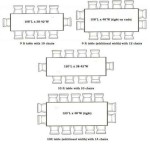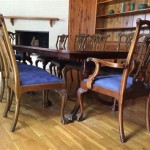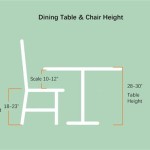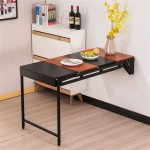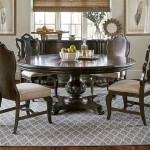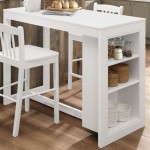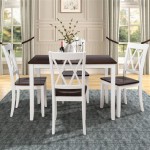Dining Room Table Ideas for Small Spaces
Optimizing space is a crucial consideration in small homes and apartments. The dining area, often a central gathering point, requires careful planning to ensure functionality without sacrificing style. Selecting the right dining room table is paramount in achieving this balance. This article explores various dining room table ideas tailored for small spaces, focusing on factors like shape, size, material, and multi-functionality. By understanding these elements, individuals can make informed decisions to create a dining area that maximizes space while serving its intended purpose effectively.
Understanding Spatial Constraints and Prioritization
Before embarking on the search for a dining room table, a thorough assessment of the available space is essential. Measure the designated dining area precisely, accounting for walkways and the placement of other furniture. Consider the number of individuals typically using the table regularly. If the table is primarily for two people, a smaller, more intimate design will suffice. However, if occasional gatherings are anticipated, a table with extension capabilities might be a more practical solution. Prioritize the primary function of the dining area. Is it solely for dining, or will it also serve as a workspace or crafting area? This understanding will greatly influence the type of table best suited to the space.
Furthermore, contemplate the overall aesthetic of the room. The dining table should complement the existing décor and style. A minimalist apartment might benefit from a sleek, modern table, while a more rustic space might call for a wooden table with a more traditional design. Consider the color palette and material of other furniture to create a cohesive and visually appealing environment. Avoiding overly bulky or ornate designs is key in small spaces, as these can overwhelm the area and make it feel even smaller.
Additionally, consider the traffic flow around the table. Ensure there is adequate space to comfortably move around the table when it is both in its smallest and largest configurations. Ideally, allow for at least 36 inches of clearance around the table. This ensures that individuals can easily pull out chairs and move around without bumping in to surrounding furniture or walls. Careful planning and consideration of these factors are fundamental to making an informed decision and selecting a dining room table that effectively addresses the limitations of the space.
Shape and Size Considerations for Small Dining Areas
The shape of the dining table significantly impacts the utilization of space. Round tables are often favored for small spaces because they eliminate sharp corners, facilitating easier movement around the room. A round table promotes conversation and creates a more intimate dining experience. However, round tables typically accommodate fewer people compared to rectangular tables of similar surface area. Another option is the square table, which offers a more modern and geometric aesthetic. Square tables are particularly suitable for small, square-shaped rooms, creating a sense of balance. However, like round tables, they might not be the most efficient for accommodating a larger number of diners.
Rectangular tables are a versatile option, particularly if the space is long and narrow. A narrow rectangular table can be positioned against a wall to save space when not in use and pulled out when needed. Consider a drop-leaf table, which has hinged leaves that can be folded down to reduce the table's size. These tables are ideal for individuals who occasionally need to accommodate extra guests but want to conserve space on a daily basis. Oval tables offer a compromise between round and rectangular shapes, providing a softer aesthetic than a rectangle while still accommodating more diners than a circle.
Selecting the right size is just as crucial as the shape. A table that is too large overwhelms the space, making it feel cramped and uncomfortable. A table that is too small might not adequately serve its intended purpose. As a general rule, allow for at least 24 inches of width per diner and 12 inches of depth to allow ample space for plates and utensils. Consider a dining table set for two or four as a starting point and expand as needed. When measuring the space, remember to account for the chairs. Choose chairs that are proportionate to the table size and consider chairs that can be stacked or folded away when not in use to further maximize space.
Material and Style: Enhancing Functionality and Aesthetics
The material of the dining room table influences both its durability and aesthetic appeal. Glass tables, for example, create the illusion of more space because they allow light to pass through, making the room feel airier. However, glass tables may require more frequent cleaning and are more prone to scratches. Wood tables offer warmth and a classic aesthetic. Opt for lighter wood tones such as birch or maple to brighten up a small space. Darker woods, such as walnut or mahogany, can make a small room feel smaller and more enclosed.
Metal tables provide a modern and industrial look. Consider a table with a metal frame and a wooden or glass top for a combination of styles. Metal is durable and easy to clean, making it a practical choice for everyday use. Laminate or veneer tables offer an affordable alternative to solid wood. These tables come in a wide range of colors and finishes, allowing for greater flexibility in matching the existing décor. However, laminate is less durable than solid wood and may be more prone to chipping or scratching.
The style of the dining table should complement the overall aesthetic of the room. A minimalist space might benefit from a sleek, modern table with clean lines and simple hardware. A more traditional space might call for a table with ornate details and a classic design. Consider the color palette of the room when selecting the table. Lighter colors make a space feel larger and brighter, while darker colors can add warmth and depth. Use chairs and other accessories to add pops of color and personality to the dining area. Consider the table's legs. Tapered legs or those with a slight curve can create a more elegant and less bulky look, which is especially beneficial in limited spaces.
Multi-Functional Dining Tables and Space-Saving Solutions
In small spaces, multi-functional furniture is invaluable. A dining table that can serve other purposes, such as a workspace or a crafting area, maximizes its utility. Consider a table with built-in storage, such as drawers or shelves, to store placemats, napkins, or other dining essentials. This eliminates the need for additional storage furniture, saving valuable space. A table with a lift-top mechanism can be used as a coffee table or a raised workspace, offering even greater versatility.
Folding tables are another excellent option for small spaces. These tables can be easily folded away when not in use, freeing up valuable floor space. Wall-mounted folding tables are particularly useful in very small apartments or studios. These tables can be folded flat against the wall when not in use, making them virtually invisible. When needed, they can be easily unfolded to provide a dining surface. Consider pairing a folding table with folding chairs for even greater space savings. These chairs can be neatly stored away when not in use, further maximizing the available space.
Extendable dining tables offer a flexible solution for individuals who occasionally need to accommodate extra guests. These tables can be expanded to accommodate more diners when needed and reduced in size when not in use. Butterfly leaf tables have a leaf that folds underneath the tabletop when not in use. Drop-leaf tables, as previously mentioned, have hinged leaves that can be folded down to reduce the table's size. Extension tables with removable leaves offer the greatest flexibility, allowing the table to be adjusted to a variety of sizes depending on the number of diners. When selecting an extendable table, ensure that the extension mechanism is easy to use and that the table is stable when fully extended. Seek out a table that has a self-storing leaf option, reducing additional storage needs. Employing these multi-functional and space-saving strategies greatly improves the usability of smaller dining area environments.

15 Small Dining Room Ideas How To Decorate Your

Use The Wall Small Dining Room Ideas 17 Clever Ways To Space Inspiration House Interior

13 Small Dining Room Ideas And Decorating Tricks

48 Brilliant Small Apartment Ideas For Space Saving Matchness Com Dining Room Table Living Combo

Small Space Dining Ideas That Maximize Every Inch

Maximize Your Space Innovative Small Dining Room Ideas For Apartments Oppein

Small Dining Rooms That Save Up On Space Room Decor Elegant

5 Dining Room Designs For Small Spaces Kevin Szabo Jr Plumbing Services Local Plumber Tinley Park Il

Small Dining Room Ideas Space Rooms

Small Dining Room Ideas Space Rooms

